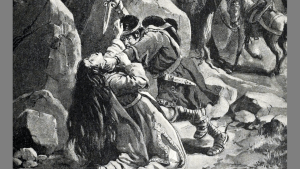At our most painful, vulnerable moments, it’s easy to feel abandoned by God. Many survivors of physical and sexual abuse struggle to see where God was in their terrible suffering or how they can feel close to him again. At times like these, the help of a good therapist is invaluable. But God offers us healing and companionship not just through counseling and medication and a supportive church community, but also through the lives of the saints who similarly experienced abuse, even at the hands of clerics. As we pray for survivors and fight for justice, let’s look also to holy men and women who were abused, finding in them inspiration, intercession, and solidarity.
St. Mary of Edessa (d. 371) was born to a noble family in Syria. She was orphaned at 7 but adopted by her uncle, the hermit St. Abraham Kidunaia (267-366). For 20 years, Mary lived as an anchoress until a wayward monk (who had spent a year grooming her) manipulated her into sleeping with him. Though Mary was truly a victim of clerical sexual abuse, she blamed herself for the abuse. Convinced that she was irredeemably sinful and unworthy of mercy, Mary ran away and became a prostitute. St. Abraham went to find her, leaving his hermitage for the first time in 20 years because his little girl needed him. He paid to spend the night with Mary, then went up to her room and fell on his knees, begging her in tears to come home. Because her father’s love showed her the Father’s love, Mary agreed and soon became a miracle worker, a testimony to God’s tremendous mercy and healing power.
St. John of the Cross (1542-1591) was, along with St. Teresa of Avila, the great reformer of the Carmelites in the 17th century, but his work made him enemies. A group of Carmelites who did not want to be reformed locked him in a tiny cell, nearly starved him to death, and beat him so brutally that though he was ultimately freed and vindicated he was scarred for life. Still he saw Christ as his bridegroom and wrote some of the most beautiful spiritual poetry ever written.
Bl. Anna Yi Si-im (1782-1816) and her family converted to Catholicism when Anna was young, and she soon discerned a call to consecrated life. She sought to move to a community of like-minded Catholic women and arranged transport with a Catholic boatman named Pak. But as soon as Pak had Anna alone, he “forced her to marry him and she gave birth to their son”; given that a marriage contracted through force is no marriage at all, the euphemism seems to indicate that Pak raped Anna, either before or after pressuring her into a sham marriage that she desperately wanted to avoid. When Pak died, the widowed single mother moved to a Christian village, where she and her son Jong-ak were later arrested for their faith. Jong-ak died in her arms and Anna was martyred.
St. Columba Kim Hyo-im (1814-1839) and St. Agnes Kim Hyo-ju (1816-1839) were Korean sisters and vowed virgins. Arrested for their faith, they were stripped naked, tortured, and thrown into a cell filled with the worst of the male prisoners. Though they were protected from any further assault, they suffered through two horrific days of huddling naked surrounded by criminals. Finally they were given their clothes and brought before a judge to stand trial for their faith. After the death sentence was handed down, Agnes stood silent, unable to speak, while Columba described the molestation they had endured. “Whether she is the daughter of a noble or a commoner,” she said, “the chastity of a young woman has the right to be respected. If you want to kill me according to the law of the country, I will willingly accept the punishment. However I do not think it is right to have to suffer insults that are not part of the law and I object to them.” The judge ordered those responsible punished, but Columba and Agnes were martyred just the same.
Bl. Laura Vicuña (1891-1904) lost her father when she was very young; her mother Mercedes became the mistress of a wealthy man, Manuel Mora. When Laura returned home from boarding school, she had to avoid Mora’s drunken kisses, once spending the night hiding in the woods as he beat Mercedes for not making Laura stay with him. Despite her mother’s negligence, Laura offered her life as a sacrifice to save Mercedes’s soul. Though Mercedes finally found the strength to leave Mora, he went to their new home and drunkenly insisted that he would stay. When Laura walked out, Mora followed her into the street and beat her until she was near death. Fearing the reprisal of the villagers who had gathered, he left her in the street. She suffered for a week before dying, having forgiven her attacker and begged her family to love God. The moment Laura died, Mercedes walked out of the house and down to the Church to make her first confession in years.

Read more:
A saint from Fatima’s neighboring town: St. Irene was a victim of sexual abuse

